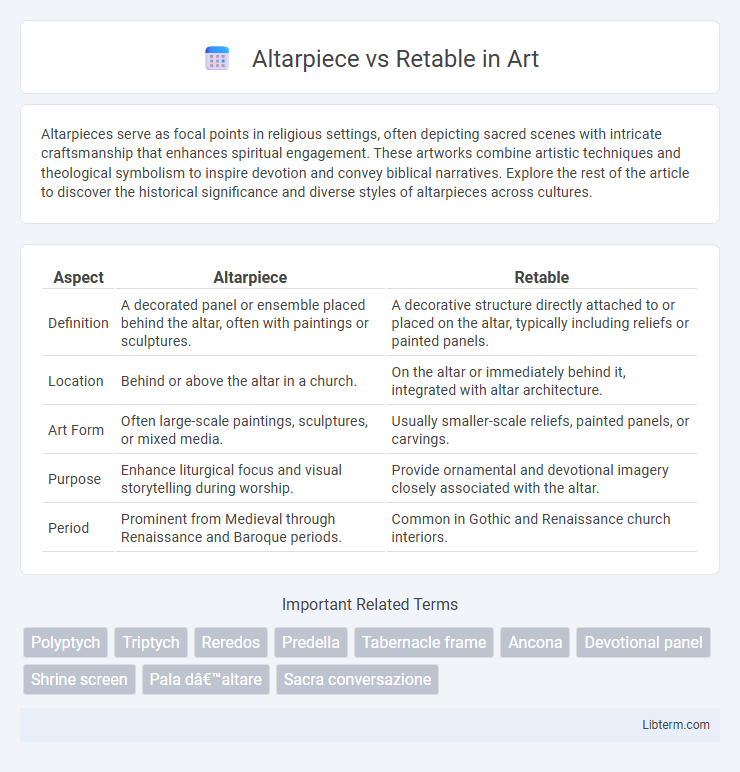Altarpieces serve as focal points in religious settings, often depicting sacred scenes with intricate craftsmanship that enhances spiritual engagement. These artworks combine artistic techniques and theological symbolism to inspire devotion and convey biblical narratives. Explore the rest of the article to discover the historical significance and diverse styles of altarpieces across cultures.
Table of Comparison
| Aspect | Altarpiece | Retable |
|---|---|---|
| Definition | A decorated panel or ensemble placed behind the altar, often with paintings or sculptures. | A decorative structure directly attached to or placed on the altar, typically including reliefs or painted panels. |
| Location | Behind or above the altar in a church. | On the altar or immediately behind it, integrated with altar architecture. |
| Art Form | Often large-scale paintings, sculptures, or mixed media. | Usually smaller-scale reliefs, painted panels, or carvings. |
| Purpose | Enhance liturgical focus and visual storytelling during worship. | Provide ornamental and devotional imagery closely associated with the altar. |
| Period | Prominent from Medieval through Renaissance and Baroque periods. | Common in Gothic and Renaissance church interiors. |
Introduction to Altarpieces and Retables
Altarpieces and retables are important elements in church art, serving as visual focal points behind altars. Altarpieces typically consist of painted or sculpted panels that depict religious scenes, while retables are architectural frameworks or decorative structures that support or surround these panels. Both enhance liturgical settings by combining artistry and spiritual symbolism, with altarpieces focusing on narrative imagery and retables emphasizing structural design.
Historical Origins and Development
Altarpieces originated in early Christian worship as visual narratives depicting saints and biblical scenes, evolving from frescoes and mosaics in catacombs to elaborately carved and painted panels during the Gothic and Renaissance periods. Retables, distinct but related, developed primarily in medieval Europe as ornamental structures placed on or behind altars, often integrating architectural elements with sculptural and painted decorations to enhance liturgical focus. Both forms advanced through the patronage of churches and wealthy benefactors, reflecting theological themes and artistic innovations from the 12th through 17th centuries.
Defining Altarpiece: Key Characteristics
An altarpiece is a devotional artwork typically placed behind or above an altar, designed to enhance liturgical settings and direct focus during worship. Its key characteristics include a multi-paneled structure or a single large panel, often richly decorated with religious iconography, scenes from the Bible, or saints. Altarpieces serve both a symbolic and narrative function, integrating intricate craftsmanship with theological themes to inspire devotion.
Understanding Retable: Essential Features
A retable is an ornamental structure or panel positioned behind an altar, often featuring intricate carvings, paintings, or sculptures that depict religious scenes or figures. Distinguished by its integration into the church architecture, a retable typically extends vertically above the altar and serves as a focal point for worshippers. Key features include multiple tiers, compartments, and the use of polychromy or gilding to enhance visual impact and spiritual symbolism.
Artistic Styles and Materials Used
Altarpieces typically feature intricate panel paintings or sculptures placed behind the altar, often crafted using tempera or oil on wood, showcasing styles from Gothic to Renaissance, characterized by vivid colors and detailed religious iconography. Retables, in contrast, encompass a broader architectural framework that may include carved wooden structures, gilded elements, and niches for statues, frequently employing polychrome techniques and materials like gold leaf and marble to enhance their three-dimensional effect. Both forms highlight evolving artistic styles from medieval to Baroque periods, emphasizing different combinations of mediums to convey spiritual narratives.
Liturgical Functions and Symbolism
Altarpieces serve as focal points behind the altar, integrating paintings, sculptures, or reliefs that depict biblical scenes to enhance liturgical worship by visually narrating sacred stories. Retables, often more architecturally elaborate and extending vertically or horizontally, frame the altar space and symbolize the heavenly realm, emphasizing the altar's role as a sacred meeting place between the divine and the congregation. Both elements function to elevate the spiritual atmosphere and support the sacramental rituals by embedding theological symbolism within their artistic compositions.
Regional Variations Across Europe
Altarpieces and retables exhibit significant regional variations across Europe, reflecting diverse artistic traditions and liturgical practices. In Italy, altarpieces often feature elaborate multi-paneled polyptychs with classical motifs, while Spanish retables are characterized by Baroque exuberance and gilded sculptural elements. Northern Europe, particularly the Netherlands and Germany, prefers painted altarpieces with detailed iconography and simpler structural forms, emphasizing narrative clarity and devotional function.
Notable Examples and Masterpieces
Notable examples of altarpieces include the Ghent Altarpiece by Jan van Eyck, a masterwork renowned for its intricate detail and vibrant color. The Retable of Sainte-Chapelle in Paris stands out as a quintessential Gothic retable, characterized by its sculptural depth and religious iconography. Both forms serve as central elements in ecclesiastical art, showcasing the evolution of devotional artistry through the Renaissance and Baroque periods.
Modern Interpretations and Preservation
Modern interpretations of altarpieces emphasize interactive and multimedia elements, transforming traditional religious art into immersive experiences. Retables, historically rich in sculptural detail, are increasingly preserved using advanced conservation techniques such as 3D scanning and climate-controlled environments to prevent deterioration. Both altarpieces and retables are central to contemporary efforts in digital archiving, ensuring accessibility and longevity of these cultural artifacts.
Altarpiece vs Retable: Key Differences Summarized
Altarpieces and retables serve distinct roles in ecclesiastical art, with altarpieces typically being large, often multi-paneled artworks placed behind the altar, designed to inspire devotion and depict religious narratives. Retables refer specifically to the structures or frameworks that support altarpieces, frequently incorporating shelves, niches, or sculptural elements and can sometimes include painted panels themselves. The key difference lies in their function and form: altarpieces are primarily the visual artwork, while retables are architectural or decorative constructions that enhance or frame the altarpiece.
Altarpiece Infographic

 libterm.com
libterm.com